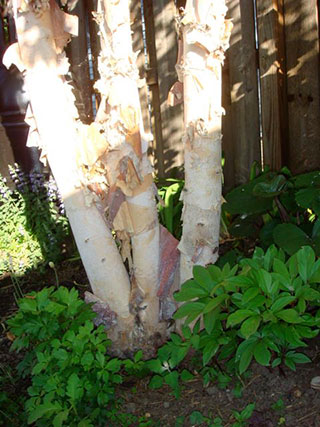






By Monique Watts for Artvoice
Strolling through filtered light on a moss-covered walkway of a woodland garden or enjoying the dappled light dancing on quaint, wispy lily of the valley through the slats of a pergola will inspire many to dream of a secret garden. But when it comes to creating a shady oasis in the yard, it can at first seem anything but tranquil.
Full sun can be a rare commodity in an urban yard. Every season we meet people wandering the plant aisles lamenting a space where nothing will grow, sighing, “It doesn’t get much sun.” Or purchasing a plant with a dooming omen of “Nothing ever lives there,” But in fact, many things might thrive in those trouble spots if the gardeners just knew what type of shade condition they were trying to populate. Not all shade is created equal, and with a bit of forethought and planning, even the most shadowy corners of your yard can be demystified.
One of the most frequent issuesis summarized thusly: “I planted that tree years ago and now it has grown so large that it shades most of my yard.” It is possible to increase the sunlight in these areas by pruning branches from the tree. However, large trees, such as oaks, demand a lot of water and nutrients from the soil, and therefore the soil below these trees can be dry. A tree’s root system can hinder the ability to turn the soil and add organic matter, so choosing drought-tolerant plants and ones that will tolerate neutral soil, along with mulching to preserve moisture, can increase plant survival rate.
Consider planting spring bulbs that will mature and bloom before the dense canopy of the trees develops. Woodland plants such as Solomon’s seal, heuchera, cyclamen, and many ferns can adapt to dry, shady conditions. Procure your wildflowers from reputable nurseries or from other gardeners who are dividing their plants to ensure that they were not illegally collected. Also, adding mature rather than tender young plants will increase the chance for survival.
For moist, partial shade areas with good drainage, the ideal plants are hostas, ferns, astilbe, foamflower, corydalis, celandine poppy, bleeding heart, bear’s breeches, monkshood, and toad lilies, all of which create a hypnotic play of color and light. Impatiens and begonias are annual favorites.
Heavily shaded areas can be a haven from the heat rather than a gardener’s curse. Those gloomy, dark spaces can be brightened with coral bells, caladium, and primrose. Moss varieties that thrive in shade can add softness. Shade-loving shrubs such as azalea, dogwood, hydrangea, and rhododendron will provide height and mass. Other shady characters to consider adopting are sweet woodruff, foxglove and columbine, and even daylilies will tolerate dappled to partial shade. Add a bench, a water feature and wind chimes, and you have it made in the shade.
Read more: http://artvoice.com/issues/v9n21/shady_characters#ixzz10xHYJtow
Copyright © www.100flowers.win Botanic Garden All Rights Reserved